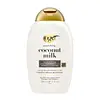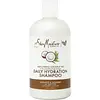What's inside
What's inside
 Key Ingredients
Key Ingredients

No key ingredients
 Benefits
Benefits

 Concerns
Concerns

 Ingredients Side-by-side
Ingredients Side-by-side

Water
Skin ConditioningSodium Methyl Cocoyl Taurate
CleansingDecyl Glucoside
CleansingCocamidopropyl Betaine
CleansingCocos Nucifera Fruit Extract
EmollientHydrolyzed Milk Protein
Skin ConditioningSodium Hydrolyzed Potato Starch Dodecenylsuccinate
Coco-Glucoside
CleansingAmodimethicone
Guar Hydroxypropyltrimonium Chloride
Skin ConditioningHydrogenated Castor Oil
EmollientGlycol Distearate
EmollientPEG-150 Distearate
EmulsifyingHexylene Glycol
EmulsifyingCitric Acid
BufferingSodium Hydroxide
BufferingSodium Benzoate
MaskingParfum
MaskingWater, Sodium Methyl Cocoyl Taurate, Decyl Glucoside, Cocamidopropyl Betaine, Cocos Nucifera Fruit Extract, Hydrolyzed Milk Protein, Sodium Hydrolyzed Potato Starch Dodecenylsuccinate, Coco-Glucoside, Amodimethicone, Guar Hydroxypropyltrimonium Chloride, Hydrogenated Castor Oil, Glycol Distearate, PEG-150 Distearate, Hexylene Glycol, Citric Acid, Sodium Hydroxide, Sodium Benzoate, Parfum
Water
Skin ConditioningDecyl Glucoside
CleansingCocamidopropyl Betaine
CleansingSodium Lauroyl Lactylate
EmulsifyingGlycol Stearate
EmollientGlycol Distearate
EmollientSodium Cocoyl Isethionate
CleansingSodium Methyl Cocoyl Taurate
CleansingGlycerin
HumectantCocos Nucifera Oil
MaskingCaprylic/Capric Triglyceride
MaskingButyrospermum Parkii Butter
Skin ConditioningAloe Barbadensis Leaf Juice
Skin ConditioningPanthenol
Skin ConditioningAlgae Extract
EmollientEquisetum Arvense Extract
AstringentTocopherol
AntioxidantRosa Canina Fruit Oil
EmollientArgania Spinosa Kernel Oil
EmollientCoconut Acid
CleansingPrunus Amygdalus Dulcis Oil
Skin ConditioningAcacia Senegal Gum Extract
Cocos Nucifera Fruit Extract
EmollientCocos Nucifera Fruit Juice
EmollientCaprylhydroxamic Acid
Caprylyl Glycol
EmollientGuar Hydroxypropyltrimonium Chloride
Skin ConditioningSodium Benzoate
MaskingPolyquaternium-7
Sodium Phytate
Stearamide Amp
Parfum
MaskingWater, Decyl Glucoside, Cocamidopropyl Betaine, Sodium Lauroyl Lactylate, Glycol Stearate, Glycol Distearate, Sodium Cocoyl Isethionate, Sodium Methyl Cocoyl Taurate, Glycerin, Cocos Nucifera Oil, Caprylic/Capric Triglyceride, Butyrospermum Parkii Butter, Aloe Barbadensis Leaf Juice, Panthenol, Algae Extract, Equisetum Arvense Extract, Tocopherol, Rosa Canina Fruit Oil, Argania Spinosa Kernel Oil, Coconut Acid, Prunus Amygdalus Dulcis Oil, Acacia Senegal Gum Extract, Cocos Nucifera Fruit Extract, Cocos Nucifera Fruit Juice, Caprylhydroxamic Acid, Caprylyl Glycol, Guar Hydroxypropyltrimonium Chloride, Sodium Benzoate, Polyquaternium-7, Sodium Phytate, Stearamide Amp, Parfum
 Reviews
Reviews

Ingredients Explained
These ingredients are found in both products.
Ingredients higher up in an ingredient list are typically present in a larger amount.
Cocamidopropyl Betaine is a fatty acid created by mixing similar compounds in coconut oil and dimethylaminopropylamine, a compound with two amino groups.
This ingredient is a surfactant and cleanser. It helps gather the dirt, pollutants, and other impurities in your skin to be washed away. It also helps thicken a product and make the texture more creamy.
Being created from coconut oil means Cocamidopropyl Betaine is hydrating for the skin.
While Cocamidopropyl Betaine was believed to be an allergen, a study from 2012 disproved this. It found two compounds in unpure Cocamidopropyl Betaine to be the irritants: aminoamide and 3-dimethylaminopropylamine. High-grade and pure Cocamidopropyl Betaine did not induce allergic reactions during this study.
Learn more about Cocamidopropyl BetaineCocos Nucifera Fruit Extract comes from the meat of the coconut fruit. It is an emollient and skin conditioner with antioxidant properties.
Coconut fruit is naturally rich in amino acids, sugars, and nutrients including Vitamin C and small amounts of vitamin B. Malic acid can also be found in coconut fruit extract.
Decyl Glucoside is a glucose-based surfactant and emulsion stabilizer. It is created by reacting glucose with the fatty acids from plants.
Surfactants help clean the skin by trapping oil, sebum, and dirt to be washed away. As an emulsion stabilizer, it stabilizes the ingredients in a product by preventing them from separating.
This ingredient is biodegradable and non-toxic. This ingredient is commonly found in baby shampoos.
Decyl Glucoside is sometimes used to stabilize the UV filter Tinosorb.
Learn more about Decyl GlucosideGlycol Distearate serves as a pearlizing or opacifying agent in cosmetic products.
It's often included in cleansers and haircare products to give them a lustrous or shimmering appearance.
It is derived from stearic acid, a natural fatty acid commonly found in vegetable oils and animal fats.
Glycol Distearate isn't fungal acne safe.
Learn more about Glycol DistearateThis ingredient is derived from guar gum.
It is a conditioning ingredient, meaning it helps soften skin and hair.
Parfum is a catch-all term for an ingredient or more that is used to give a scent to products.
Also called "fragrance", this ingredient can be a blend of hundreds of chemicals or plant oils. This means every product with "fragrance" or "parfum" in the ingredients list is a different mixture.
For instance, Habanolide is a proprietary trade name for a specific aroma chemical. When used as a fragrance ingredient in cosmetics, most aroma chemicals fall under the broad labeling category of “FRAGRANCE” or “PARFUM” according to EU and US regulations.
The term 'parfum' or 'fragrance' is not regulated in many countries. In many cases, it is up to the brand to define this term.
For instance, many brands choose to label themselves as "fragrance-free" because they are not using synthetic fragrances. However, their products may still contain ingredients such as essential oils that are considered a fragrance by INCI standards.
One example is Calendula flower extract. Calendula is an essential oil that still imparts a scent or 'fragrance'.
Depending on the blend, the ingredients in the mixture can cause allergies and sensitivities on the skin. Some ingredients that are known EU allergens include linalool and citronellol.
Parfum can also be used to mask or cover an unpleasant scent.
The bottom line is: not all fragrances/parfum/ingredients are created equally. If you are worried about fragrances, we recommend taking a closer look at an ingredient. And of course, we always recommend speaking with a professional.
Learn more about ParfumSodium Benzoate is a preservative. It's used in both cosmetic and food products to inhibit the growth of mold and bacteria. It is typically produced synthetically.
Both the US FDA and EU Health Committee have approved the use of sodium benzoate. In the US, levels of 0.1% (of the total product) are allowed.
Sodium benzoate works as a preservative by inhibiting the growth of bacteria inside of cells. It prevents the cell from fermenting a type of sugar using an enzyme called phosphofructokinase.
It is the salt of benzoic acid. Foods containing sodium benzoate include soda, salad dressings, condiments, fruit juices, wines, and snack foods.
Studies for using ascorbic acid and sodium benzoate in cosmetics are lacking, especially in skincare routines with multiple steps.
We always recommend speaking with a professional, such as a dermatologist, if you have any concerns.
Learn more about Sodium BenzoateThis gentle cleansing and foaming ingredient is known for leaving a smooth feeling in skin and hair. It is made using coconut oil.
According to the manufacturer, it is soluble in water and has resistance to hard water, acid, and alkali.
Due to its coconut base, it may not be Malassezia folliculitis safe.
Learn more about Sodium Methyl Cocoyl TaurateWater. It's the most common cosmetic ingredient of all. You'll usually see it at the top of ingredient lists, meaning that it makes up the largest part of the product.
So why is it so popular? Water most often acts as a solvent - this means that it helps dissolve other ingredients into the formulation.
You'll also recognize water as that liquid we all need to stay alive. If you see this, drink a glass of water. Stay hydrated!
Learn more about Water